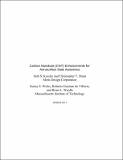Carbon Nanotube (CNT) Enhancements for Aerosurface State Awareness
Author(s)
Kessler, Seth S.; Dunn, Christopher T.; Wicks, Sunny S.; de Villoria, Roberto Guzman; Wardle, Brian L.
DownloadWardle_Carbon Nanotube.pdf (400.0Kb)
OPEN_ACCESS_POLICY
Open Access Policy
Creative Commons Attribution-Noncommercial-Share Alike
Terms of use
Metadata
Show full item recordAbstract
The goal of the present effort was to develop an integrated system capable of reliable ice-deterioration, de-icing and anti-icing in addition to structural diagnostics to enable aerosurface state awareness. The basis for the system is nanoengineered structured carbon nanotube (CNT) enhancements that can either be embedded within the composite laminates during manufacturing, or applied as a separate surface layer in a secondary process. The aligned CNTs are sufficiently long (20-30 um) to span interply matrix regions, acting as mechanical reinforcement in addition to improving electrical conductivity by a factor of more than a million. Optimized electrode patterns are applied to the CNT-enhanced structure, and hardware provides closed-loop feedback control. Ice-deteriation is based on effective heat capacity, where power is applied to CNT-enhanced laminates (termed fuzzy fiber reinforced plastic, or FFRP) for seconds, and the slope of the temperature rise can be correlated to the thickness of ice present. For de-icing (melting) and anti-icing (prevention of ice formation) a resistive heating principal is used. Voltage is applied to the FFRP material, which heats rapidly due to the small but finite resistance imparted by the CNTs. Structural diagnostics is achieved by monitoring and mapping changes in electrical resistance across electrode grid paths.
Date issued
2011-09Department
Massachusetts Institute of Technology. Department of Aeronautics and AstronauticsJournal
Proceedings of the Eighth International Workshop on Structural Health Monitoring, September 13-15, 2011
Publisher
DEStech Publications, Inc.
Citation
International Workshop on Structural Health Monitoring. “Structural Health Monitoring 2011: Condition-based Maintenance and Intelligent Structures.” DEStech Publications, 2011. Print.
Version: Author's final manuscript
ISBN
978-1-60595-053-2